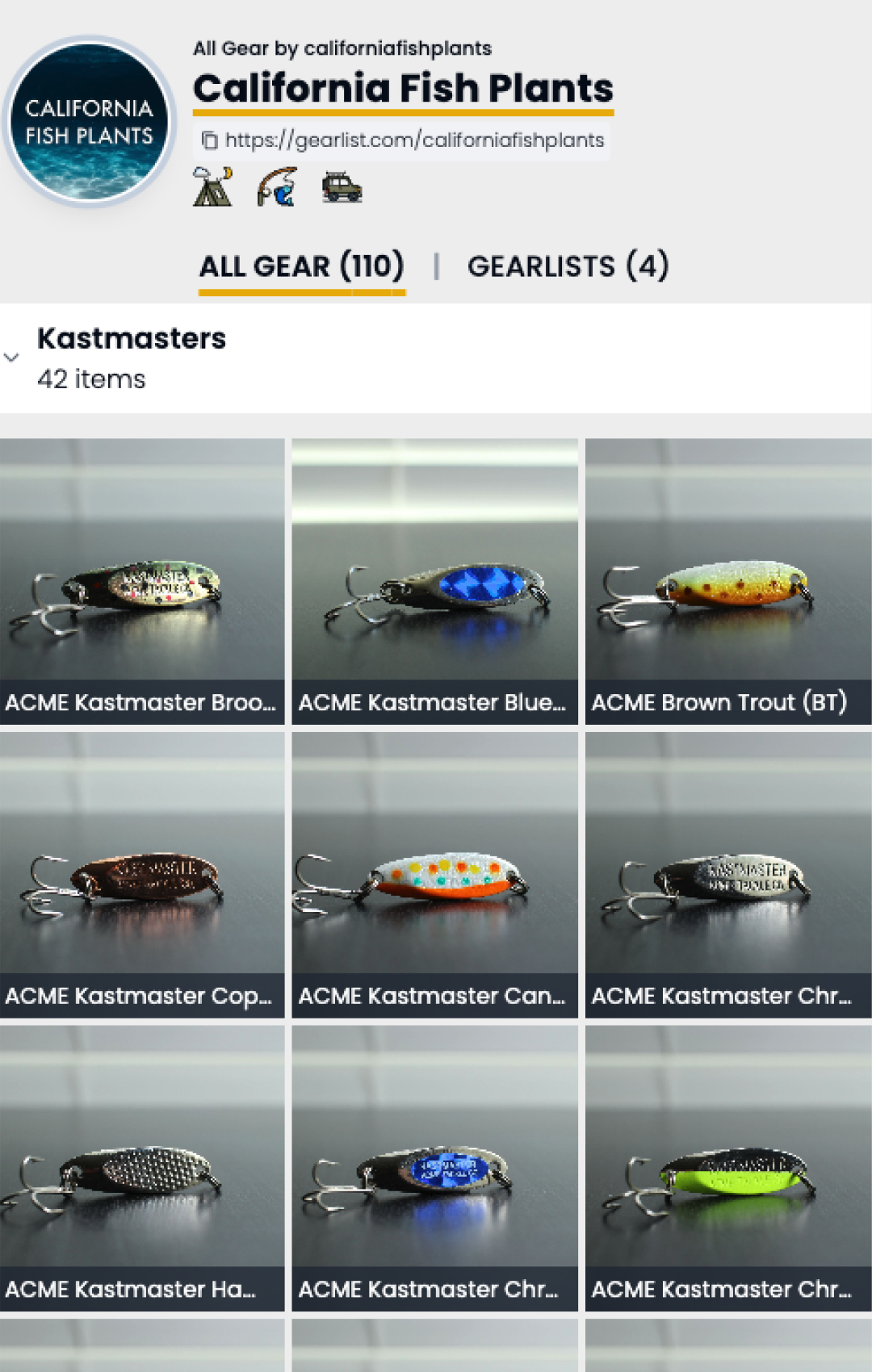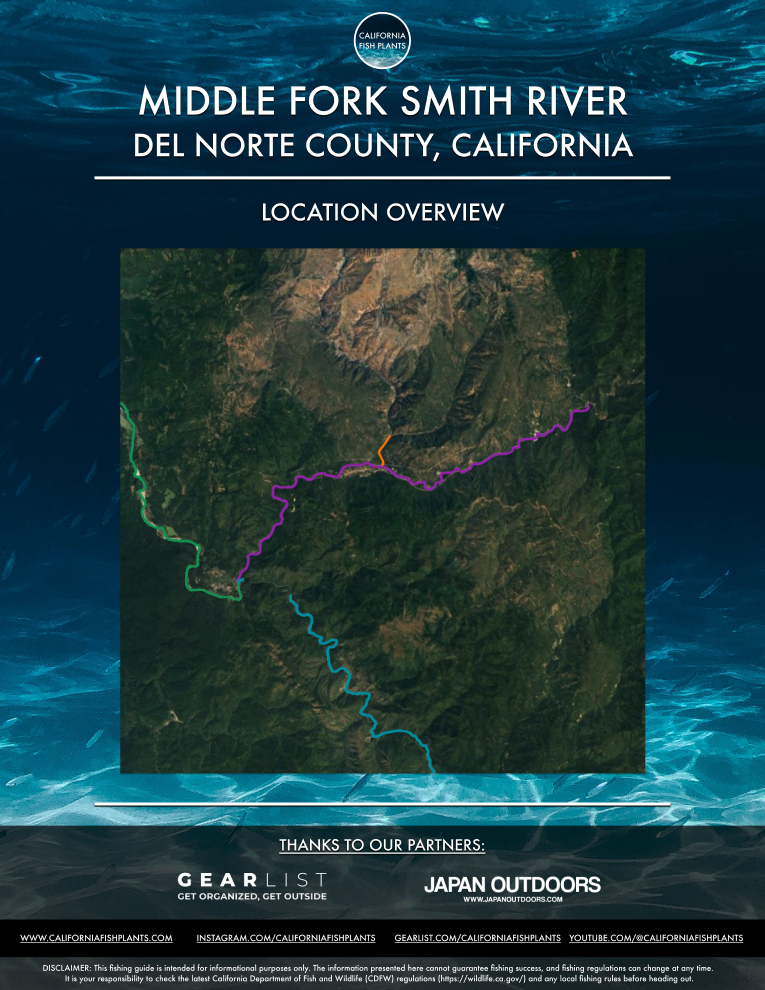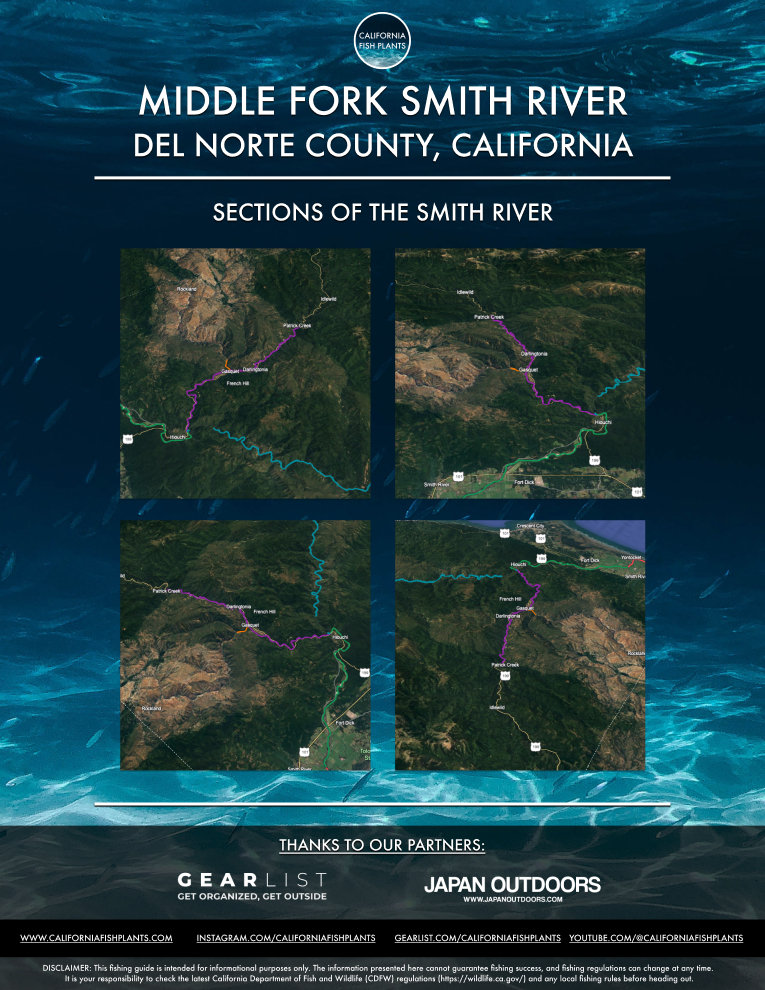If you’ve been searching for a wild, untamed fishing spot, look no further than the Middle Fork Smith River. Nestled in California’s Redwood Empire, this secluded river offers anglers a pristine, natural environment with a diverse array of fish species. Whether you’re a seasoned pro chasing trophy steelhead or a beginner looking for an immersive fishing experience, the Middle Fork Smith River promises an adventure like no other. Here’s what you need to know to make the most of your trip, from the best times to fish to essential tips and gear.
📈 Latest Fish Plants
Fish here often?
How To Read Fish Plant Graphs
To interpret fish plant graphs effectively, consider the following key elements:
- Blue Vertical Bars and Numbers:
- Representation: The blue vertical bars on the graph represent individual fish plants.
- Weight Measurement: The associated numbers indicate the total weight of the plants in pounds (lbs.) that occurred during a specific week.
- Significance: Monitoring these bars helps identify weeks with higher planting activity, aiding anglers in selecting optimal times for fishing near recent plantings.
- Orange Trend Line:
- Purpose: The orange trend line represents the moving average of all fish plant activities at the specified location.
- Indicator of Activity: A rising trend line suggests a consistent increase in planting activity over the designated period. This indicates the potential for more catch opportunities and signifies a growing fish population over the weeks.
- Interpreting the Moving Average:
- Upward Trend: A rising moving average implies an upward trajectory in planting activity, indicating an increasing number of fish being introduced into the area. This suggests a positive outlook for anglers, as it implies a larger and potentially more accessible fish population.
- Downward Trend (Not Specified): The description does not provide information on the interpretation of a decreasing trend in the moving average. It might be beneficial to include information on what a decreasing trend could signify in terms of fishing prospects.
- No Data Present:
- Possible Explanations: If no data is visible on the graph, it may indicate that the location had no fish plants in the last three months. Alternatively, the absence of data could be due to non-disclosure of fish plants for that location.
- Natural Population: Some fishing areas in California rely on the natural growth of fish populations, and graphs may not show plants if this is the case.
- Graph Disclaimer:
- Data Source: The graphs reflect a combination of publicly disclosed data and estimates. Some locations may disclose fish plants without specifying exact amounts.
- Not Universal: Not all fishing areas have fish plants, and the natural growth of fish populations plays a significant role in many California fishing locations.
Understanding these elements will empower anglers to make informed decisions about when and where to fish based on historical fish plant data.
Note: If no data is present in the graph above, this location may not have had any plants the last 3 months, or may not have publicly disclosed plants. Graphs reflect both publicly disclosed data and estimates, as some locations disclose plants, but not exact amount.
🗺️ Map & Fishing Location
(click to zoom in)
New to California Fish Plants & Need an Access Code?
Why Fish the Middle Fork Smith River?
The Middle Fork Smith River is unlike most other fishing destinations. With crystal-clear waters, it boasts thriving populations of steelhead, rainbow trout, cutthroat trout, and even the occasional king salmon. Located along U.S. 199, the Middle Fork remains relatively undiscovered, offering a quiet, serene experience free from heavy crowds.
Steelhead Trout: The crown jewel of this river, steelhead are known for their powerful runs and acrobatic leaps. These fish, particularly during their spring and fall migration, offer a rewarding challenge. Anglers from all over dream of landing one of the Middle Fork’s legendary steelhead.
Rainbow Trout: Rainbow trout are found throughout the year, adding vibrancy and action to your fishing experience. Known for their strong fighting spirit and beautiful coloration, they’re a constant favorite for anglers on the Middle Fork.
Cutthroat Trout: Native to the area, cutthroat trout call the headwaters of the Middle Fork home. While smaller than steelhead, their spirited fight and delicate flavor make them highly sought after, particularly during the spring and summer months.
King Salmon: Though not as frequent as other species, king salmon do make an appearance during their fall migration. These powerful fish are known for their size and strength, adding another layer of excitement to the already thrilling fishing opportunities on the Middle Fork.
A River With a Rich History
The Middle Fork Smith River isn’t just a great place to fish; it’s steeped in history and natural beauty. One of California’s few undammed rivers, it flows through some of the most breathtaking landscapes in the state. The narrow, rugged terrain of the Middle Fork, combined with its crystal-clear waters, creates the perfect environment for trophy fish, especially the 20-pound steelhead that have made this river famous.
What makes this river even more special is its relative seclusion. While it’s accessible from U.S. 199, the Middle Fork remains a hidden gem, largely untouched by out-of-town anglers. Its remote location preserves its pristine beauty and offers a fishing experience that feels worlds away from the crowded rivers you might be used to.
Key Tips for First-Timers on the Middle Fork Smith River
If this is your first time fishing the Middle Fork, here are a few tips to help you get the most out of your experience:
- Approach Stealthily: Fish in the Middle Fork are smart and easily spooked. To avoid scaring them off, approach the water with caution, staying at least 30 feet back when casting. Keep your movements slow and steady to blend into your surroundings.
- Scout Your Spots: U.S. 199 offers plenty of pullouts where you can stop and assess the water. If you see another vehicle parked, it’s a good idea to move on to another spot to maximize your chances of finding an undisturbed fishing hole.
- Campground Access: The Forest Service maintains several campgrounds along the river that offer easy access to some of the best fishing stretches. Staying overnight allows you to get an early start, which is key to finding the best spots.
- Use Light Tackle: The Middle Fork’s clear waters mean that fish can spot heavy lines easily. Opt for a 6- to 8-pound test Maxima line to keep your setup light and less visible to the cautious fish.
- Soak in the Scenery: The Middle Fork Smith River is more than just a fishing destination—it’s a natural wonder. Whether or not you land a fish, take time to enjoy the tranquility and beauty of your surroundings.
Best Times to Fish the Middle Fork Smith River
Timing is crucial when planning your trip to the Middle Fork Smith River. While fish are present year-round, the best fishing occurs during the spring and fall when steelhead and salmon make their runs. These are also the most pleasant times to be out on the water, as the weather is cooler and the fish are more active.
Spring: Spring is peak season for steelhead. As they migrate upstream to spawn, they become more aggressive and easier to catch. This is also a great time to target rainbow trout, which are more active during the cooler months.
Fall: Fall brings not only steelhead but also the possibility of catching a king salmon. The cooler temperatures and spawning runs make this one of the best times to fish the Middle Fork, as the river is teeming with life.
Gearing Up for the Middle Fork Smith River
Success on the Middle Fork starts with having the right gear. Here’s a breakdown of what you’ll need to tackle the fish in these waters:
- Rods: If you’re targeting steelhead or salmon, you’ll want a medium- to heavy-action rod paired with a 10- to 12-pound test line. For trout, a lighter setup with a 4- to 6-pound test line will give you the sensitivity needed for smaller fish while still holding strong enough for a fight.
- Reels: Make sure your reel matches the strength of your rod and is in good working condition. Steelhead are strong fighters, and you don’t want to be caught with a malfunctioning reel when you hook into one of these powerful fish.
- Lures and Baits: For steelhead and salmon, spinners, spoons, and flies are your go-to options. For trout, small jigs, minnows, and worms work best. Having a variety of lures on hand allows you to adjust based on conditions and fish behavior.
- Additional Gear: The Middle Fork is remote, so come prepared. Bring extra layers, maps, communication devices, and a first aid kit. Waders and rain gear are also essential, as the weather can change quickly, and being dry and comfortable makes all the difference.
- Explore Our Gearlist: For a full list of gear recommendations tailored to fishing the Middle Fork, check out our Gearlist. We’ve put together a selection of rods, reels, lures, and other essentials to help you maximize your time on the water.
Respect the River
The Middle Fork Smith River is one of California’s last wild rivers, and it’s crucial that anglers practice responsible fishing to preserve it. Always follow local regulations, and practice catch-and-release whenever possible to help maintain healthy fish populations. Additionally, make sure to pack out all your trash and leave the river as beautiful as you found it.
Techniques for Success
Fishing the Middle Fork requires a blend of patience, strategy, and adaptability. Here are a few tried-and-true techniques to boost your chances of success:
- Fish Riffles, Pools, and Runs: These areas are where fish congregate to feed and rest. Riffles provide oxygenated water, pools offer shelter, and runs act as pathways for migrating fish. Focusing on these spots will increase your odds of hooking into something.
- Adjust to the Season: In spring, focus on deeper pools where steelhead are likely to be resting. In fall, look for shallower areas where trout and salmon are more active. Adapting your approach to the season and conditions is key to success.
- Change Lures as Needed: Don’t be afraid to switch up your bait or lure if you’re not getting bites. Fish behavior can change based on water temperature, clarity, and other factors, so having a variety of options is always a good idea.
- Patience Pays Off: The fish here are smart and cautious, so it may take a while to get a bite. But when you do, the fight will be worth the wait. Stay focused and be ready when the moment comes.
- Talk to Locals: If you can, seek out advice from experienced anglers who know the river well. Their insights into where the fish are biting and what techniques are working can save you time and effort.
Final Thoughts: More Than Just a Fishing Spot
The Middle Fork Smith River isn’t just another place to fish—it’s a sanctuary where anglers can reconnect with nature. Every cast into its clear waters offers the chance to catch not only fish but also a sense of tranquility and peace that’s hard to find elsewhere. Whether you’re here for the challenge of reeling in a trophy steelhead or simply to enjoy the quiet beauty of the Redwood Empire, the Middle Fork will leave a lasting impression.
So pack your gear, hit the road, and experience the magic of the Middle Fork Smith River. Whether you return with a cooler full of fish or just memories of a day well spent, you’ll find yourself already planning your next trip back.







